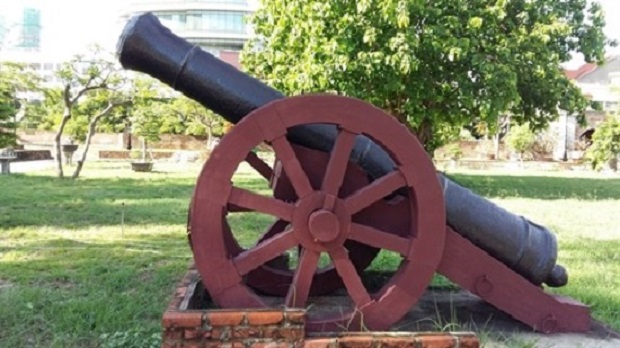Dien Hai Citadel's cannons proposed as national treasures
The Da Nang government recently proposed that 11 cannons which were previously stored in the city’s former Dien Hai Citadel should be recognised as national treasures. The cannons are now on display at the Museum of Da Nang.
 |
| One of the cannons on display at the museum |
A cannon is a heavy piece of artillery, typically mounted on wheels, which uses gunpowder or other explosive-based propellants to launch heavy metal or stone cannonballs a great distance. They first appeared in Europe in the 13th century, and were mostly made of bronze, iron or cast iron.
The 11 cannons on display at the museum were cast in iron during the feudal Nguyen Dynasty between 1802 and 1860. Each of them is made up of many parts, including a caliber, carriage and a cylindrical barrel slightly larger towards the rear and featuring a vase-shaped muzzle. The cannons’ lengths range from 1.15m to 3.05m.
These weapons were all found in the city between 1979 and 2008. In detail, 7 of them were unearthed at the former site of the Dien Hai Citadel, whilst 3 were excavated at a location which was about 200m away from the site, and the remaining one was discovered on the eastern side of the river.
According to historical documents on display at the museum, the Nguyen Dynasty created many weapons and established military ramparts along local beaches in order to ensure a local defensive system against foreign invaders.
Situated on the western side of the Han River, the Vauban-style Dien Hai Citadel had 2 gates, the main one facing south and the other facing east. It featured warehouses where food and ammunition were stockpiled, and 30 large cannon emplacements. The citadel was one of the most important fortresses in Viet Nam in the 19th century, and was recognised as a national historical relic on 16 November 1988 by the Ministry of Culture and Information.
The Dien Hai Citadel witnessed the victory of Viet Nam over the French-Spanish troops invading the country in 1858. At that time, the Vietnamese army comprised more than 4,000 militants from Nam Ngai and Binh Phu provinces, under the leadership of Governor Nguyen Tri Phuong. The cannons at the citadel, along with other local coastal military ramparts at that time, played a vital role in defeating the attacks by the French invaders in the 1858 - 1860 period.
The 11 cannons are valuable historical artifacts of Da Nang, and Viet Nam as a whole. They are considered to be vivid evidence of the undaunted courage and indomitable fighting spirit of the city’s soldiers and local residents during their battles against the foreign invaders in the 1858 - 1860 period.